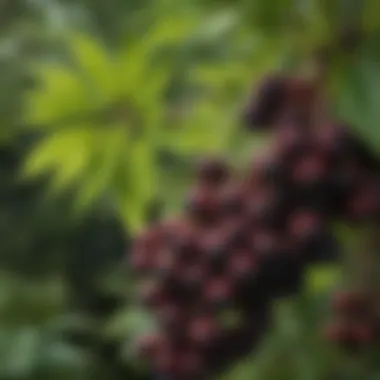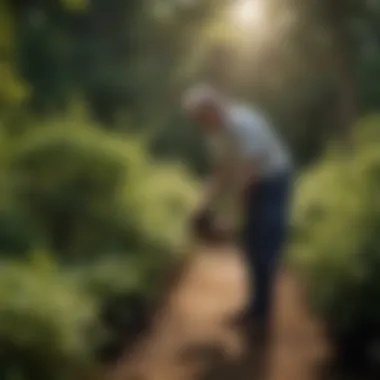A Comprehensive Guide to Purchasing Elderberry Plants


Intro
Elderberry plants hold significant value in both gardening and health circles. Acquiring these plants requires informed decisions to ensure healthy growth and optimal yields. Understanding the diverse options available for purchasing elderberry plants is fundamental. This guide delves into the various avenues for sourcing elderberries, including insights into nurseries, online shops, and local markets.
The selection process transcends mere acquisition. It involves evaluating the quality of plants to ensure a fruitful gardening experience. For those new to gardening, the journey might appear daunting, but with adequate information, anyone can successfully cultivate these vibrant plants. Moreover, seasoned plant enthusiasts will also benefit from tips on growing elderberries efficiently.
Elderberries are not just ornamental; they possess health benefits too. These plants produce berries that are rich in vitamins and antioxidants, thus playing a role in enhancing the immune system.
As we navigate this guide, we will cover critical factors essential for making informed choices, ensuring that both novices and experienced gardeners have the necessary tools for success.
Preamble to Elderberry Plants
Elderberry plants possess both practical and ecological significance in the gardening landscape. Recognized for their berries, which are used in a variety of culinary applications and natural remedies, these plants are not only valuable to individual gardeners but also contribute positively to local ecosystems. Understanding the intricacies of elderberry plants is crucial for anyone seeking to cultivate them, whether for personal enjoyment or broader horticultural goals.
Overview of Elderberry
Elderberries, primarily belonging to the genus Sambucus, are deciduous shrubs that thrive in various climates, making them adaptable for cultivation. The two common types, Sambucus nigra and Sambucus canadensis, are noted for their striking foliage, fragrant flowers, and nutrient-rich berries. These plants grow rapidly and can reach heights up to 12 feet or more, depending on their variety and growing conditions. Besides their aesthetic appeal, elderberries play a critical role in supporting wildlife, providing food and shelter for numerous bird species and insects.
Health Benefits of Elderberries
Elderberries are celebrated for their numerous health benefits. They are rich in vitamins A, C, and E, making them beneficial for the immune system. Studies suggest that elderberry extracts can reduce the duration and severity of cold and flu symptoms. Additionally, the antioxidant properties of elderberries help in combating oxidative stress within the body, contributing to overall health and wellness. Consequently, incorporating elderberries into one’s diet not only enriches culinary experiences but also promotes better health outcomes.
Understanding Types of Elderberry Plants
Elderberry plants are more than just ornamental additions to gardens; they have complex structures and diverse attributes that can greatly influence their cultivation and uses. Understanding the different types of elderberry plants is crucial for anyone looking to grow these versatile shrubs. Each species, particularly Sambucus nigra and Sambucus canadensis, presents unique benefits and characteristics. This knowledge aids in making informed decisions, ensuring that gardeners select the best variety for their specific needs.
Sambucus Nigra
Sambucus nigra, commonly known as black elderberry, is one of the most recognized elderberry varieties. It thrives in various climates and is particularly known for its dark berries, rich in anthocyanins, which are known for their antioxidant properties. These berries can be used to prepare a variety of products, from syrups to jams, which have gained considerable attention in health and wellness circles.
This species is typically larger in size compared to its counterparts, capable of growing up to 12 feet tall. It also possesses distinct, serrated leaves that can add texture to your garden. The flowers of Sambucus nigra, creamy white in color, are fragrant and attractive to pollinators. Their presence can help contribute to overall biodiversity in your garden.
When considering Sambucus nigra, it is essential to factor in its requirements for optimal growth. It prefers well-drained soil and full sunlight, although it can tolerate partial shade. This species is also more resistant to certain pests and diseases, making it an excellent choice for less experienced gardeners. In essence, choosing Sambucus nigra can offer both aesthetic appeal and fruitful yields, promoting both beauty and utility in any garden.
Sambucus canadensis
Sambucus canadensis, also referred to as American elderberry, is another prominent type of elderberry worth exploring. This shrub typically grows up to 6 to 12 feet tall and is native to North America. Similar to Sambucus nigra, it produces white flowers followed by clusters of small, dark berries. These berries, although slightly less potent in antioxidants than Sambucus nigra, still provide significant health benefits and can be used in numerous culinary applications.
An important aspect of Sambucus canadensis is its adaptability to different soil types. It thrives in moist, well-drained soils and can be planted in a range of environments, from backyards to wetlands. This feature makes it an appealing option for those interested in creating natural habitats or restorative gardens.
In summary, both Sambucus nigra and Sambucus canadensis possess unique attributes, catering to the diverse needs of gardeners and health-conscious individuals. By understanding these species better, one can make a more informed decision when purchasing elderberry plants, ultimately leading to a more fruitful gardening experience.
"Choosing the right type of elderberry is essential not just for growth but for maximizing the potential benefits, both culinary and ecological."
Recognizing the variances between these elderberry species allows for smarter cultivation practices and reflects an appreciation for the flora that benefits our ecosystems.
Where to Buy Elderberry Plants
Purchasing elderberry plants can seem straightforward, yet it involves careful consideration of where to buy them. The options range from local sources to online shops. Each avenue has its pros and cons that can greatly impact the quality of your plants and your overall experience. Understanding these elements is crucial for making the best choice.


Local Nurseries
Local nurseries are often the best places to start your search for elderberry plants. They usually have knowledgeable staff who can provide valuable guidance regarding the specific varieties suited for your region. Visiting a local nursery allows you to inspect the plants firsthand. You can evaluate their health, growth, and suitability for your garden environment. It also supports local businesses, fostering a sense of community.
However, local nurseries might have limited varieties compared to larger retailers. Their stock can be seasonally dependent. For instance, you may find a particular species unavailable at certain times, which could restrict your options.
Garden Centers
Garden centers are another viable option for purchasing elderberry plants. Typically larger than local nurseries, these centers offer a wider selection and a variety of gardening supplies. Many garden centers also provide helpful resources, such as workshops or literature on best gardening practices.
When buying elderberries from garden centers, look for signs of plant health, such as vibrant leaves and well-maintained roots. They may have a higher turnover of stock than smaller nurseries, which can sometimes mean fresher plants.
Farmers' Markets
Farmers' markets provide a unique opportunity to buy elderberry plants directly from local growers. This can be advantageous for finding organic options or plants grown without chemical fertilizers. The personal interaction with vendors allows you to ask about care specifics and growing conditions, which may not be available through larger retailers.
However, availability can be inconsistent. Not all farmers’ markets will have elderberry plants at any given time. It's advisable to check with vendors in advance or visit markets during peak gardening seasons.
Online Retailers
Online retailers have become increasingly popular for purchasing elderberry plants. They provide convenience and a broader selection of varieties. Websites may offer in-depth descriptions and reviews, helping you make well-informed decisions.
Yet, buying plants online can carry some risks. It is crucial to choose reputable online retailers. Check for customer reviews to measure their credibility. Consider shipping practices, as plants must be transported carefully to prevent damage. Ensure that the site provides clear information on return policies in case the plants arrive in subpar condition.
As you consider where to buy your elderberry plants, weigh these options carefully. The quality and health of the plants can significantly affect your gardening success. By exploring local nurseries, garden centers, farmers' markets, and online retailers, you can find the best fit for your gardening needs.
Evaluating Online Options for Purchasing
Purchasing elderberry plants online can provide numerous advantages, such as convenience and access to a broader selection. However, evaluating online options requires careful consideration due to the varied quality and reliability of sellers in the digital marketplace. It is essential to scrutinize online choices based on several factors—chiefly, the reputation of the website and the feedback from previous customers.
By understanding these elements, you can mitigate the risks associated with online purchasing and ensure that you make an informed decision that aligns with your gardening needs and expectations.
Reputable Websites
When considering where to buy elderberry plants online, choosing reputable websites is crucial. Reliable online retailers usually have established histories, positive reputations, and a comprehensive catalog of plants. Here are some distinguishing characteristics of reputable online retailers:
- Well-Established Brands: Websites such as Burpee, High Country Gardens, and Elderberry Farms have dedicated years to gaining customer trust around plant purchases.
- Clear Policies: A reputable website will outline their shipping, return, and guarantee policies in detail, which adds transparency to the buying process.
- Quality Assurance: Look for websites that provide detailed information about their plants, including growing conditions, care instructions, and certifications of health.
Always remember to check for secure payment options as well. A secure site is often indicated by a padlock in the address bar and a URL starting with "https://".
Customer Reviews and Ratings
Taking note of customer reviews and ratings is another essential step in evaluating online options for purchasing elderberry plants. Customer feedback serves as a vital resource for gaining insight into the quality of both the plants and the service provided by the seller. Important aspects to consider include:
- Rating Systems: Many online retailers feature star ratings for their products. A high average rating typically indicates customer satisfaction.
- Detailed Feedback: Read individual customer reviews that mention the plant's condition upon arrival, growth success, and any possible issues. This can provide a clearer picture of what to expect.
- Response to Complaints: Observe how the seller responds to negative reviews. Prompt and solutions-focused responses often indicate good customer service, which is crucial for after-purchase support.
Gathering this information before making a purchase is essential for ensuring that the elderberry plants you acquire are of high quality and suited for your gardening ambitions.
Selecting Quality Elderberry Plants
Selecting quality elderberry plants is paramount for ensuring the success of your gardening endeavor and reaping the benefits associated with these plants. Healthy elderberries can provide not only a fruitful harvest but also contribute to the aesthetic value of your garden. This section will explore the significant aspects that define quality plants and what elements should be considered during the selection process.


Signs of Healthy Plants
When considering elderberry plants, it's crucial to identify specific signs of health. Look for the following attributes to assess the vitality of the plants:
- Vibrant Leaves: Healthy elderberry plants exhibit lush, green leaves free of discoloration. Leaves should be firm and not wilted.
- Strong Stems: A robust stem indicates a strong plant. Avoid plants with weak or brittle stems, as they may struggle to support fruit growth.
- Root Development: Examine the roots, if possible. Healthy root systems are typically white and firm, indicating that the plant can absorb nutrients well.
- Absence of Pests: Look for any signs of pest infestation, such as holes or visible insects on the leaves and stems. Pests can significantly impact plant health.
Carefully inspecting these features can prevent the acquisition of subpar plants. Healthy elderberries will not only grow better but also yield more fruit.
Common Issues to Avoid
There are several common pitfalls to steer clear of when selecting elderberry plants. Awareness of these issues will facilitate informed decisions and lead to a thriving garden:
- Diseased Plants: Be cautious of any plants that show signs of disease, such as unusual spots or mold. These can spread and ruin your garden.
- Overgrown Specimens: While it may seem appealing, overgrown plants can indicate neglect. They might carry latent issues related to improper care or disease.
- Poorly Rooted Plants: Plants that appear root-bound or have roots circling the pot may struggle to establish properly in your garden. This condition can hinder healthy growth and fruit production.
- Inconsistent Care: Ensure that the plants have been cared for adequately. Look for signs of stress due to inadequate watering or fertilization.
In summary, selecting quality elderberry plants is an essential step for any successful gardening undertaking. By focusing on the signs of healthy plants and avoiding common issues, you set a solid foundation for growth, production, and overall satisfaction in your home garden.
Propagation of Elderberry Plants
Propagation plays a crucial role in cultivating elderberry plants. It serves as a gateway for gardeners to expand their collection and enhance biodiversity in their spaces. By understanding the methods of propagation, one can maximize yield while ensuring the vitality of elderberries. This section discusses various methods, highlighting their benefits, considerations, and best practices, valuable for anyone interested in these versatile plants.
Cuttings vs. Seeds
When it comes to establishing new elderberry plants, there are two primary methods: using cuttings or seeds. Each method has distinct advantages and challenges.
- Cuttings:
- Seeds:
- Using cuttings is often the preferred approach. Stem cuttings enable quicker establishment, as they can produce roots without going through the initial germination phase.
- This method is particularly effective in the spring or late summer when the growth is robust.
- It is generally successful; however, specific conditions must be met to ensure healthy root development.
- Growing from seeds can be more rewarding yet requires patience. Elderberry seeds usually need to be stratified; this mimics natural winter conditions, triggering germination.
- The process takes longer compared to cuttings, as seeds do not guarantee a clone of the parent plant.
- If you're experimenting with different varieties or looking for genetic diversity, seeds may be the better option.
Both methods can yield fruitful results, but cuttings are often recommended for those seeking efficiency.
Best Practices for Propagation
Successful propagation hinges on applying best practices, ensuring that plants thrive.
- Choosing the Right Time:
- Healthy Material:
- Soil and Environment:
- Observation and Adjustment:
- Timing is essential. For cuttings, spring or late summer provide optimal conditions due to favorable weather.
- Seeds should be sown after the last frost, providing the right temperature and conditions for growth.
- Select healthy parent plants. The vitality of the cutting or seed directly influences the success of propagation.
- Avoid any parts that show signs of disease or pest damage.
- Use a well-draining potting mix to support root development. Elderberry plants prefer slightly acidic to neutral pH levels.
- Maintain consistent moisture, but avoid over-watering. A humidity dome over cuttings can help retain moisture.
- Monitor your cuttings or seedlings closely. Adjusting light exposure and humidity can lead to better results.
- Be prepared to make changes; every environment is different.
Propagation not only aids in cultivating elderberries but also allows for sharing with others and preserving the species. Proper techniques ensure that the investment of time and effort leads to successful plant growth.
Growing and Caring for Elderberries


Growing elderberries is more than just a gardening hobby; it is an investment in a plant that provides nutritional and culinary benefits. Understanding how to care for these plants ensures a bountiful harvest and keeps them healthy. This section discusses the essential factors related to their growth, offering insights on ideal conditions and common problems.
Ideal Growing Conditions
To thrive, elderberry plants require specific conditions that mimic their native environments. Here are crucial elements to consider for optimal growth:
- Soil Type: Elderberries prefer well-drained loamy or sandy soil, rich in organic matter. A pH level between 5.5 and 7.0 is ideal. Testing soil before planting can avoid issues later.
- Sunlight Exposure: These plants thrive best in full sun, receiving at least six hours of direct sunlight daily. Insufficient light can lead to weak growth and reduced berry production.
- Water Requirements: Consistent moisture is key. During dry spells, elderberries need regular watering, but ensure the soil doesn’t become waterlogged. Overwatering leads to root rot, a common problem among elderberry growers.
- Spacing: When planting elderberries, allow for sufficient space between plants. This ensures good air circulation and minimizes the risk of disease. A spacing of 6 to 10 feet apart is often recommended, depending on the variety.
Understanding these factors can significantly enhance the health of the elderberry plants, making the journey from seedling to berry-bearing more successful.
Common Pests and Diseases
Despite their resilience, elderberries may face threats from pests and diseases. Identifying these early can help in managing them effectively.
- Pests: Common pests include aphids, spider mites, and Japanese beetles. Regularly inspecting leaves and stems can help spot these issues. Using insecticidal soap is an effective way to control these infestations.
- Diseases: The most prevalent diseases affecting elderberries are fungal infections such as powdery mildew and root rot. To prevent fungal issues, ensure adequate spacing and prune away affected areas. Additionally, maintaining good soil health through proper watering can curb root rot.
- Preventative Measures: Adopting integrated pest management strategies can greatly enhance the resilience of the plants. This means combining cultural practices, biological control, and occasional chemical treatments when necessary.
"Healthy elderberry plants not only provide fruit but also contribute to ecological diversity."
Culinary Uses of Elderberries
Elderberries have been utilized for culinary purposes for centuries. Their rich flavor and numerous health benefits make them a sought-after ingredient in various dishes. This section explores making elderberry syrup and incorporating elderberries into recipes, emphasizing their versatility and advantages in cooking.
Making Elderberry Syrup
Elderberry syrup is a popular product made from the berries of the elder tree, particularly the Sambucus nigra variety. It is often touted for its immune-boosting properties, especially during the cold and flu season. The process of making elderberry syrup involves a few straightforward steps:
- Ingredients: Gather fresh or dried elderberries, water, cinnamon sticks, ginger, and honey (for sweetness).
- Preparation: Boil the elderberries with water, cinnamon, and ginger. Allow the mixture to simmer for an hour, letting the flavors meld and the berries release their properties.
- Straining: Once cooled, strain the mixture to remove the solid parts, leaving only the liquid.
- Sweetening: Blend in honey to taste while the syrup is still warm. This step not only sweetens but also adds health benefits to the syrup.
The resulting syrup can be taken directly, used as a sweetener, or incorporated into drinks. It serves not only as a flavor enhancer but also as a medicinal supplement, promoting overall health.
Incorporating Elderberries into Recipes
Elderberries can be used in a variety of culinary applications, extending far beyond syrup. Some ways to incorporate them into your cooking include:
- Baked Goods: Add elderberries to muffins, pancakes, or tarts for a unique flavor. Their natural sweetness pairs well with cereals and baked products.
- Jams and Jellies: Elderberry jelly is another popular treat. Combined with sugar and pectin, elderberries make a delicious spread for bread and toast.
- Soups and Sauces: They can also be used to enrich sauces or soups, providing depth and a touch of sweetness.
- Beverages: Besides syrup, elderberries can be steeped in tea or blended into smoothies, making for refreshing drinks.
The versatility of elderberries opens many possibilities for creativity in the kitchen. Their distinct flavor profile not only enhances dishes but also offers the added benefit of nutrition and health advantages. This makes elderberries an excellent choice for both professional chefs and home cooks alike.
Culmination
In this article, the conclusion serves a pivotal role. It encapsulates the essential insights gathered from the previous sections regarding purchasing elderberry plants. Readers, particularly those who are forestry professionals and academics, benefit from a concise summary of key points which guide them through the complexities of selecting quality elderberries while making informed decisions about sourcing.
Key elements in the conclusion include reevaluating the various options for purchasing, recognizing the significance of ensuring plant health, and understanding how sustainable practices contribute to the broader environmental impact. Each of these aspects enhances the reader's knowledge and approach to gardening with elderberries, fostering a more environmentally conscious mindset.
Summarizing Key Takeaways
- Understanding Plant Varieties: Recognizing the difference between Sambucus Nigra and Sambucus canadensis is crucial. Each species has unique properties and preferred growing conditions that influence yields and health benefits.
- Sources for Purchase: Purchasing from local nurseries, garden centers, or reliable online retailers ensures that the plants are acclimated to the local climate and soil conditions. This guarantees higher success rates in growth.
- Healthy Plant Signs: Knowing how to identify healthy elderberry plants, including checking for vibrant foliage and strong stems, can significantly reduce the likelihood of issues post-purchase.
- Propagation Techniques: Understanding the best methods for propagating elderberry, whether through cuttings or seeds, enhances the gardener’s capabilities to expand their collection sustainably.
- Culinary Applications: Leveraging elderberries in culinary practices, such as making syrup or incorporating into various recipes, not only enriches diets but also highlights the value of these plants in everyday life.
Encouraging Sustainable Practices
Promoting sustainable practices is vital for the longevity of elderberry cultivation. Here are several recommendations for readers:
- Local Sourcing: Purchase elderberry plants from local nurseries to reduce carbon footprint. Supporting local businesses strengthens community ties and promotes biodiversity in local ecosystems.
- Organic Cultivation: Utilize organic gardening methods when growing elderberries. This includes avoiding synthetic fertilizers and pesticides, which can harm beneficial insects and soil health.
- Proper Care: Adopting good agricultural practices such as crop rotation and soil management ensures that elderberry plants flourish for many years, contributing to ecosystem health.
- Education and Sharing: Engaging in community gardens or local gardening clubs allows for the sharing of knowledge. This fosters an environment where sustainable practices become second nature.
"By cultivating elderberry plants using sustainable methods, you contribute not only to your personal health but also to the health of the planet."
In summary, the conclusion mirrors the relevance of the entire article, reinforcing the importance of making informed, sustainable choices when purchasing and growing elderberry plants.



